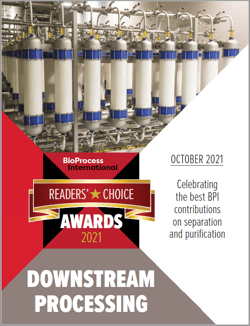DOWNSTREAM PROCESSING
 Regardless of molecule, the goal of biopharmaceutical downstream processing is to reduce process- and product-related impurities while maintaining the highest possible process yield. However, emerging modalities such as those based on gene-edited human cells, transgenes carried by viral vectors, and proteins transferred by exosomes all are pointing out limitations in current downstream strategies, which by and large have been developed around purification of monoclonal antibodies (MAbs).
Regardless of molecule, the goal of biopharmaceutical downstream processing is to reduce process- and product-related impurities while maintaining the highest possible process yield. However, emerging modalities such as those based on gene-edited human cells, transgenes carried by viral vectors, and proteins transferred by exosomes all are pointing out limitations in current downstream strategies, which by and large have been developed around purification of monoclonal antibodies (MAbs).
This year’s nominees in the BPI Readers’ Choice downstream category highlight technologies and processing strategies that biopharmaceutical developers and manufacturing organizations are developing to address the separation and purification demands raised by innovative therapies. Hundley and Königsson chronicle their team's development of a fully single-use disc-stack centrifuge system that is designed for high-density cell cultures. Kamstrup and other writers with the BioPhorum industry consortium explore how a simple mathematical tool combined with failure mode and effects analysis can help biomanufacturers to predict quantitatively a viral-inactivation process's risk for carryover contamination from pre- to postviral steps. Law et al. showcase a proprietary ligand-based exosome affinity purification (LEAP) platform that could enhance the scalability, reproducibility, and cost-effectiveness of extracellular vesicle purification. And Winkler et al. describe their application of noninfectious viral surrogates to assess the viral-clearance potential of a downstream process for a product based on adenoassociated virus (AAV).
Fill out the form below to read the eBook and learn the Readers' Choice winners now.






